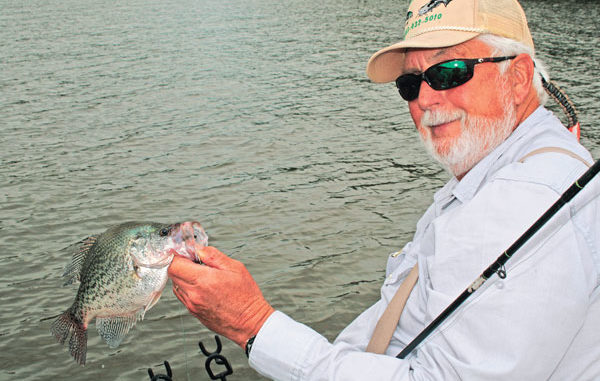
Hot weather means hot action on Lake Wateree crappie.
Crappie fishing on Lake Wateree in August may not be at the top of everyone’s list in terms of great action, but anglers targeting crappie may want to rethink that perception.
Wateree is one of the better crappie fisheries in South Carolina, and just because the days are scorching hot doesn’t mean the crappie won’t cooperate.
According to Buster and Russell Rush, a father-and-son team that guides fishermen on Wateree and other local lakes, some very good reasons exist for fishing in August and into the fall months.
“The lake has a couple of things going for it in terms of hot-weather crappie fishing,” said Buster Rush (803-432-5010), who lives in Camden. “First, the lake is full of big, fat crappie, which is one reason we love it. During August and later into the fall, the lake is stratified, and a very definite thermocline is established. This ensures the crappies have a specific depth preference where the water conditions are favorable, and thus they are more likely to be found in that particular zone. It eliminates a lot of water as unproductive, and we can focus our efforts where the fish are congregated.
“We have found that the depth for that thermocline is usually around 16 to 18 feet, and that depth range is a real key to summertime success at Lake Wateree.”
Both Rushes — Buster, 68, has been guiding since 1993, and Russell, 45, started guiding in 1997 — agree that the key to summertime success on Wateree is depth, patience and perseverance, and finding fish.
“The key to summertime fishing at Lake Wateree is finding woody cover at the right depth,” Buster Rush said. “One of the keys to our success is knowing where a lot of brushpiles are located. We have placed in them a variety of depths so we can fish depths from 20 feet deep to shallow water. But usually the thermocline will set up in the 16- to 18-foot depth range. That’s a good starting point when looking for crappie on Lake Wateree during the summer.”
Russell Rush said that presentation is certainly a key to success and having the patience to fish several areas, looking for a place that has a large number of fish located on it.
“Patterns will not only change from day to day at this time of the year, they’ll change during the course of a day,” he said. “The key to success will be to carefully work the brush, stump rows, fallen logs or whatever form of woody cover you can locate in a specific depth pattern that produces.
“Sometimes, we’ll find the fish in 14 feet of water, for example, and that’s where most of the fish will be. Depth will be so critical that we may catch only a few at 13 feet or 15 feet. Once we find a pattern like that, we’ll fish similar places and generally pick up several fish at each place until the pattern changes. The pattern change can be associated with time of day, the onset of cloud cover or losing cloud cover. Crappie fishing in the summer can be very productive, but it can also be a very finicky process.”
Buster Rush said that live minnows are his lure of choice at Wateree during the summer.
“Minnows work great, because on a tightline rig, I can have total control of the depth presentation on each individual place I fish,” he said. “That’s very important, because often only a foot or two of difference will have a big impact on the fish you catch. Typically, we’ll hold the rod in our hand and feel for the bite instead of fishing several rods and watching rod tips for bites.
“Overall, because of the nature of the crappie bite in hot weather, we’ll usually catch a lot more fish in this manner at this time of the year. Of course, at different times of the year, we’ll pull multiple rods and will longline troll in the spring. But fishermen need to understand that fishing the hot weather of August and into the early fall can be a much different situation.
“During the summer months, we’ve found it best to hold the rod and feel for the bite. Plus, this enables me to make quick adjustments on depth by pulling in or letting out just a few inches of line. Often that small adjustment can make a big difference.
“It’s important to fish just above the depth the crappie are holding or right at their eyeball level,” he said. “I believe they basically are looking up for food, not down, and they will readily come up a few inches for bait but not down. Also, I’ve found the bite is often very light during the summer, but by holding the rod, a fisherman can certainly feel the bite when tightlining minnows.”
Buster Rush said that his rig is simple, with the terminal tackle consisting of a No. 2 or 4 wire hook with split-shot aobut eight inches above it. He said Nos. 3 or 4 size split-shot works best. He will use 12-pound test or even heavier line during the summer.
“I generally use as light a line as possible when crappie fishing,” he said, “but the nature of fishing heavy cover forces us to use slightly heavier line during the summer than we use during the spring. But with a precise presentation and holding the rod to feel for the bite, we usually have no problem catching plenty of crappie. With the heavier line, when we do get snagged, which is going to occasionally occur, we can usually pull the rig out without breaking the line and disturbing the fish.”
Russell Rush said that often the crappie will be holding right at the top of the brushpile, so if there’s brush in 18 feet of water and the brush sticks up six feet off the bottom, he’ll usually start in about 12 feet of water fishing around the top limbs of the brush.
“If fishing around the top of the brush doesn’t produce, then I’ll drop the bait down into the brush a bit,” he said. “The potential for getting snagged on the brush or other woody cover will increase, but sometimes that’s where the fish will be holding, so that’s where we have to put the bait.
“The basic pattern is to use the electric motor to slowly ease the boat over the brush so we are fishing directly over and into it if necessary. We’ll stop the boat a good distance from the cover and slip in quietly.”
Buster Rush said that as a general rule, the crappie will be holding near the main lake and Catawba River channel.
“The drops, humps and ledges along the river channel are great places to fish,” he said, “but a lot of points that drop into deep water on the main lake are also perfect places to find fish. Also, the mouths of some of the large coves and creeks that feed into the lake are excellent places.
“A graph is very important to fishing success at this time of the year,” Buster Rush said. “A graph will usually depict where the thermocline is established in terms of depth and will depict the brush and hopefully scattered fish around that brush. In addition, another key for us is to find areas where there is ample forage fish as well. With the warm water temperatures, crappie will be feeding and they will usually be in the area of the lake where there are plenty of shad.”
Don’t let the summer heat keep you from catching crappie during the summer. According to Buster and Russell Rush, both quality and quantity of crappie are ready and willing at Lake Wateree.

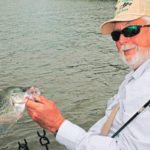
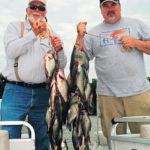
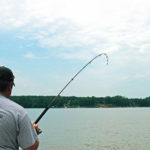
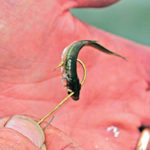
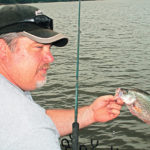
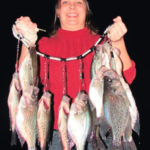
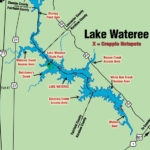

Be the first to comment